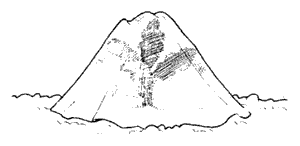Using Spinosad
A new organic insecticide is now avaiable that is very effective agains the cucumber beetle and hurts no beneficial insects. It is called Spinosad. Go to the Spinosad file in Yardener's Tool Shed to learn about the effectiveness of the this product. Click Here
Using Other Natural Insecticides
Neem oil soap is a natural insecticide that will kill cucumber beetles on contact and then repel new arrivals for about 2 weeks. Pyrethrum is made from chrysanthemum blossoms and is quite effective especially when applied directly to the pest. Go to the Natural Insecticides section in Yardener’s Tool Shed for details on each product.
Using No Insecticides
Control Cucumber Beetles With Barriers
 |
Unless plants are trained to a trellis, you can easily protect them from cucumber beetles with garden fleece, also called floating row cover. This lightweight spun-bonded fabric allows sun, air, and rain to get through while keeping out the beetles as long as the entire plant is covered. Cover transplants or a newly seeded area with the material immediately; lay it directly on the plants or over a tunnel structure. Seal all the edges to the ground, and leave the barrier on at least until blossoms appear, after which it will need to be removed to allow insects to reach the flowers to pollinate them. You can leave the row cover over the plants all season if you are growing plants that do not need external pollination, such as “parthenocarpic” cucumber varieties. (Such plants are able to set fruit without being pollinated by bees.)
Coffee can trick:
If garden fleece is impractical in your situation, you can still protect individual transplants against the beetles with small screened enclosures . Cut out both ends of a coffee can, cover one end with a square of fleece fabric held in place with a stout rubber band, and set the other end into the ground around the plant. This works better with a five pound coffe can because as the plant exceeds the size of the can, you must remove it. The bigger can gives you protection longer.
Control With Diatomaceous Earth
Dust diatomaceous earth (D.E.) around the base of each plant to create a barrier to cucumber beetles, or dust the whole plant with D.E. Dusting should progress upward from the ground, covering all stems and leaves, especially the undersides. D.E. is made up of tiny, sharp-edged particles of silica that work by rupturing the pest insect’s thin outer shell, causing it to lose vital moisture. The insect eventually dies of dehydration. Dust in late evening or at night to minimize D.E.’s effects on beneficial insects.
Control By Hand Picking
Light infestations of cucumber beetles are easy to control by hand picking. Crush the beetles between thumb and forefinger, squeezing them as they feed on leaves and stems. Another way is to clip or pinch off beetle-infested plant tips and discard them in the trash. Or fish them out of hiding places under cucumber flowers with tweezers, or just pick the flowers. If done early in the season several days in a row, this will not harm the plant and may, in fact, encourage it to branch and become bushier. Remember also to pull out and destroy old vegetable and annual planting at the end of the season, to reduce overwintering sites for the beetles.
Spent Blossom trap trick:
If your plants are in the blooming stage, you can trap some beetles inside the spent blossoms. They gather there after the pollinated blooms begin to wither and collapse together. Check the blossoms in late evening. If you see any beetles inside, pick the flowers and (drop)them into a bucket of soapy water to dispose of them.
Control With Predatory Nematodes
Predatory nematodes are an effective biological control against cucumber beetles. Mix the powdered microscopic roundworms with water according to package directions and spray the slurry in an 18-inch circle around the base of plants at a rate of 50,000 worms per plant, or at the rate of 50,000 per foot on row crops like beans. Be sure to check the label to know what the soil temperature must be to allow for successful transfer of the nematodes into the soil. Use a hand pump sprayer , hose end sprayer. watering can, or pail. Unlike the harmful root-knot nematodes which attack plants, predatory nematodes only attack soil-dwelling insects. The worms will seek out beetle larvae as hosts for their eggs, killing them. This approach is not guaranteed to work, but is worth the effort, because success rates are improving with increased quality of the nematode product in recent years.
Using Insecticides
Using Natural Insect Repellents
There are several natural insect repellents that often kill cucumber beetles on contact, but also serves as a repellent by creating a bad taste for the critter and make it go someplace else to munch. Neem Oil Soap, Hot Pepper Wax, and Garlic Barrier all have this potential repellent capability when applied properly on the tops and the bottoms of leaves of the target plant. The repelling effect will last for several weeks to a month depending on the weather conditions. See the Natural Repellents in Yardener's Tool Shed.
Using Synthetic Insecticides
The pyrethroid class of insecticides are effective in controlling cucumber beetles. Go to Yardener's Tool Shed to check out the options in the Synthetic Insecticides section.

